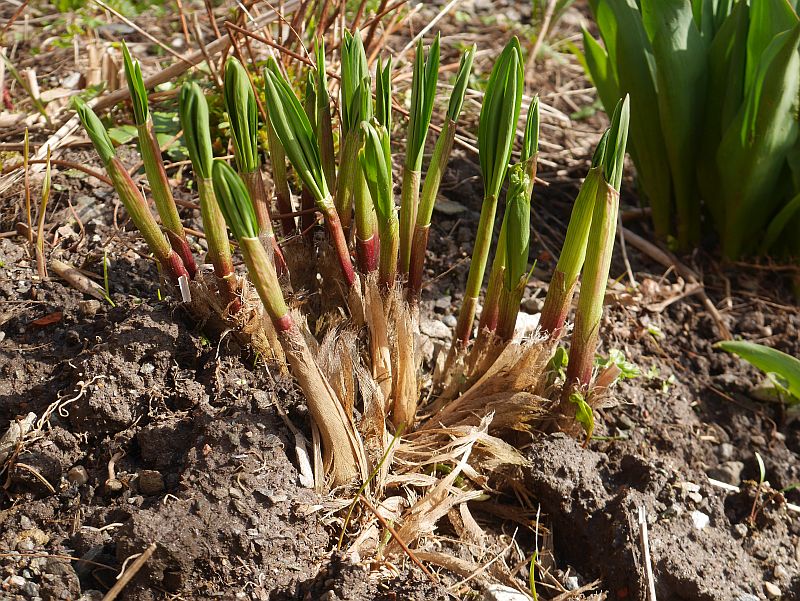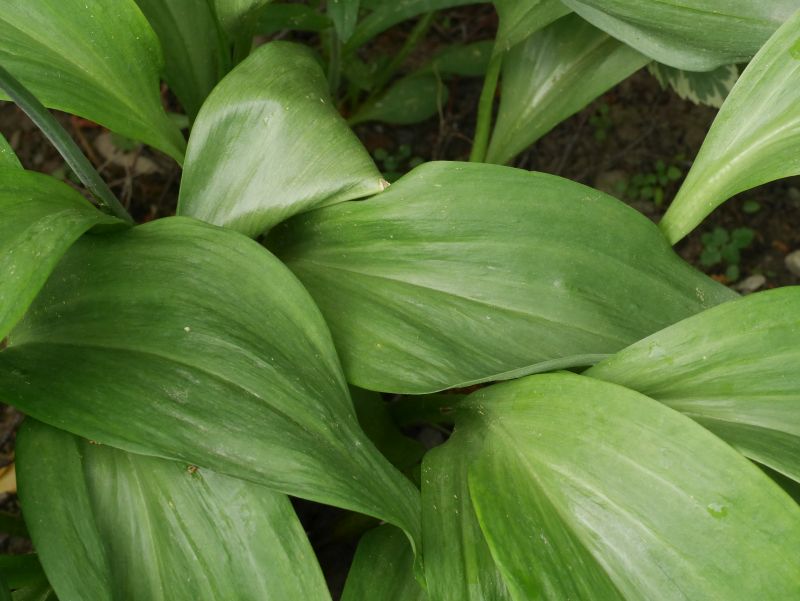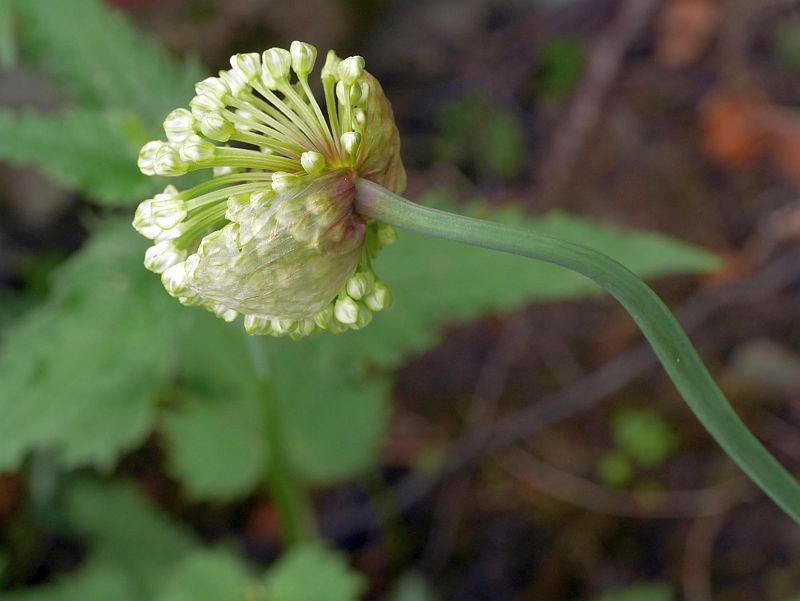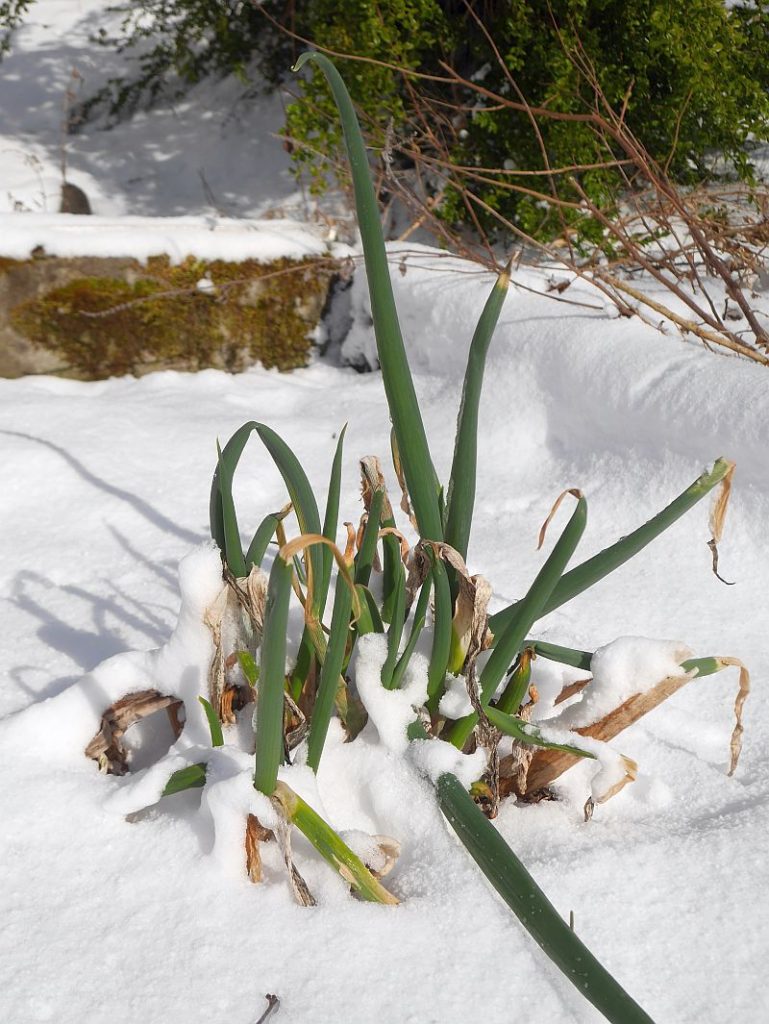No, I’m not vegan and have never been, I’ve been lactovegetarian with the occasional wild fish over 40 years. We always have some Norwegian dried cod (baccalao) at the ready in our cool larder. The usual way to make the dish baccalao here is to hydrate the fish for a couple of days and then layer potatoes, bulb onions, fish, tomatoes, garlic with olive oil, pepper and chili in large saucepan. I’ve always added seasonal greens too and often use green onions of various types instead of bulb onion.
Last night, we used the last of the potatoes from the cellar and as there weren’t many also used root chicory (di Sancino: an edible rooted variety that produces well here) and the last yacon roots, all still in perfect condition kept in the cellar in dryish leaves all winter! We also used a good bunch of nettles, tops of giant bellflower (Campanula latifolia) and sweet cicely (Myrrhis odorata) tops including the flowers. For the onions, sand leek (Allium scorodoprasum) and victory onion (Allium victorialis) were in perfect condition (beginning to flower).
The verdict on our first bitter baccalao? Delicious, but probably not for everyone!
Tag Archives: Allium victorialis
Allium ulleungense: a new vigorous edimental
In 2019, a very interesting paper was published giving a very good case for splitting the geographically widespread Allium victorialis species complex, at the same time describing a new endemic species to the island Ulleung between Korea and Japan. The paper also mentions that the species is “Rare in natural habitats, but widely cultivated in Korea as an edible plant named ‘Myeong-i-na-mul’ or ‘Sanmaneul.’”
Reference: “Allium ulleungense (Amaryllidaceae), a new species endemic to Ulleungdo Island, Korea” by Hyeok-Jae Choi, Sungyu Yang, Jong-Cheol Yang and Nikolai Friesen in the Korean Journal of Plant Taxonomy
Those who follow my blog and FB posts will maybe remember my article on the Giant Ulleung Celery, Dystaenia takesimana, another edible endemic to this island which I’m growing in my garden from two sources, one of which is the Gothenburg Botanical Gardens in Sweden (see http://www.edimentals.com/blog/?p=24998)
Figure 4 in the paper (below) shows a map of Allium subg. Anguinum showing the disjunct distribution of what was earlier classified as Allium victorialis, now split into Allium victorialis, microdictyon, ochotense and the new species Allium ulleungense together with other species in the section like Allium ovalifolium.
The article has a useful table and pictures showing the differences between microdictyon, ochotense and ulleungense.
I have about 10 different “Allium victorialis” accessions in my garden both from Norway, Kola (Russia), the Alps and the Far East. Having read the paper which documents that the Ulleung victory onion has both broader and longer leaves I noticed that one of my plants had very different and broader leaves than my other ones and was particularly vigorous. I had lost the label of this plant. Johan Nilson of the Gothenburg Botanical Garden wrote on the Alliorum forum thread about this species: “I believe we might grow this” (they had had an expedition to the island some years ago and this onion and Dystaenia had been collected). Johan had given me various edibles on a visit to Gothenburg a few years ago and I wonder if he might have given me this plant?
Anyway, the morphology of this plant fits well to the newly described species with several leaves 12 cm wide (ochotense reaches 10 cm and microdictyon 6 cm); leaves up to 26-27 cm long (the other two species reach 25 and 21.5cm) and yesterday I measured the white tepals which are slightly longer in the new species and this also matched with 7mm length (the others reaching 6.5). The rounded leaf apex of my plant also matches ulleungdense, acute in the other two species (and other Japanese accessions I have in my garden). I now need to propagate it and plant it in the Allium garden Chicago at the Ringve Botanical Garden.
Today’s permaveggies
Presenting the 14 permaveggies used in tonight’s Indian dal!
Here are the ingredients:
Around the outside:
Blanched sea kale / strandkål (Crambe maritima)
Stinging nettle / brennesle (Urtica dioica)
Top left and anti-clockwise:
Caucasian spinach / stjernemelde (Hablitzia tamnoides)
Hedge garlic / løkurt (Alliaria petiolata)
Cow parsnip (Heracleum lanatum)
Day lily / daglije (Hemerocallis shoots)
Common wintercress / vinterkarse (Barbarea vulgaris)
Giant bellflower / storklokke (Campanula latifolia)
Blanched lovage / løpstikke (Levisticum officinale)
Ground elder / skvallerkål (Aegopodium podograria)
Victory onion / seiersløk from the Lofoten Islands in Norway (Allium victorialis)
In the middle:
Great waterleaf (Hydrophyllum appendiculatum) grows well in my garden and self-sows. It’s natural habitat is damp calcareous woodlands in Eastern North America.
Patience dock / hagesyre (Rumex patientia)
Afterthought:
Moss-leaved dandelion / mosebladet løvetann (Taraxacum sublaciniosum “Delikatess”) – one entire leaf rosette with dandichokes and top of the roots)
Unintentional presents
Yesterday was my birthday and the best presents were all unintended as birthday presents:
1. Allium victorialis from a large stand that has naturalised from a farm garden in Nordland county, Norway to be offered to various members of KVANN (Norwegian Seed Savers) when I get time (From Inger Elvebakk, who also took the picture):
2. A new sea kale / strandkål (Crambe maritima) accession from a KVANN member, from a wild population
3. Decorah Posten took over a month to get here, but it arrived too on my birthday (see https://en.wikipedia.org/wiki/Decorah_Posten); more about this another time!
Victory falafels
Falafels can be home grown over most of Norway and if we are serious about climate change should become standar fare in kitchens, restaurants and supermarkets throughout the country. Dig for VICTORY against climate change!
The ingredients:
Broad beans / fava beans (bondebønner); grown in Malvik and stored dried
Victory onion (seiersløk) grows particularly well in the arctic (or replace with garlic or ramsons)
Golpar (spice from ground seed of any member of the Heracleum genus, including invasive Tromsøpalme, Heracleum persicum)
Barley flour (bygg) – I used100% whole grain
Eggs to bind
Fry in oil (sorry, I used imported olive oil)
(Optional: house grown chilis)
Decoration: Oxalis triangularis



Earliness and diversity in Victory Onion
Victory onion or seiersløk (Allium victorialis) in Norwegian has one of the most widespread geographic distributions in the Allium genus from the Pyrenees to the Far East. In Norway, it’s naturalised in the Lofoten Islands, a few places in Nordland county and one location in Hardanger (Granvin). There is evidence to believe that it was originally introduced to Norway by the Vikings. I have plants from different parts of its range in my garden and there is a large difference between them as to when they begin to shoot in the spring, the ones deriving from Japan leafing out a few weeks earlier than the ones from Europe and Norway, although a plant received as Allium ochotense (nowadays considered by most as a synonym of A. victorialis), which originated in the Tromsø botanical garden, is probably from the Russian Far East and is also a late variety. Below are pictures of most of my plants taken on 19th and 20th April 2020. I have about 5 other accessions, two not big enough to photograph, one from the Kola peninsular has not grown well and will be moved to a new location, 3 more were planted this spring. two donated by the Oslo botanical garden and one a variegated form from Japan: Allium victorialis subsp. platyphyllum ‘Chiri Fu’.
1) From a seed trade with Iku Kubota in Japan in 2002.
2) From Tei Kobayashi in Japan in 2016 (subsp. platyphyllum or broad-leaved victory onion) has a flower bud extending
3) From seed from the Reykjavik botanical garden in 2009, originatin from the Sakhalin in the Russian Far East. This one also has a flower bud and has broadish leaves.
4) Received from the Tromsø botanical garden in 2002
5) From Granvin in Norway in 2012
6) From Merete in Lofoten in 2003
7) From Anja Angelsen. Krogtoft, Vestvågøy, Lofoten, Norway (2009)
8) From Massif Central in the French Alps (kindly sent to me by the Haut-Chitelet alpine garden in 2013) 
9) From naturalised plants in Hopen, Nordland, Norway in 2013 10) Probably Allium victorialis Cantabrica AMH 7827 (collected by Antoine Michael Hoog, the son of one of the founders from Van Tubergen); I received it as Cantabria in 2008.
10) Probably Allium victorialis Cantabrica AMH 7827 (collected by Antoine Michael Hoog, the son of one of the founders from Van Tubergen); I received it as Cantabria in 2008.
Mass Victory Onion Germination
Mass germination around one of my victory onions /seiersløk (Allium victorialis). I’m not sure where this accession originates.

Onions in the snow
Several Alliums are extremely hardy and can stand green all winter even when exposed to temperatures under -20C. Similarly, young leaves of species that start to sprout in early spring as soon as the frost disappears near the surface have no problem with snow and frosts. Here are a few after yesterday’s snowfall!
Japanese victory onion
Allium victorialis earlier this week in the garden. I harvested half of these shoots. This is an accession I received seed from Iku Kubota in Japan in December 2002. 
Self-produce from the garden
Here’s yesterday’s fresh produce* from the garden….the joy of perennial vegetables! However, snow overnight will make harvest more difficult the next few days! Here’s today’s list:
Aegopodium podograria (ground elder / skvallerkål)
Allium hymennorhizum
Allium sativum (garlic / hvitløk)
Allium cernuum (noddding onion/ prærieløk)
Allium victorialis (victory onion / seiersløk)
Rumex acetosa “Arkhangelsk” (sorrel / engsyre)
Hemerocallis middendorfii (day lily / daglije)
Brassica oleracea (various perennial kales / flerårige kål)
Hablitzia tamnoides (Caucasian spinach / stjernemelde)
Myrrhis odorata (sweet cicely / spansk kjørvel)
Ficaria verna (lesser celandine / vårkål)
Taraxacum officinale ” Moss-leaved” (dandelion / løvetann)
Angelica archangelica “Vossakvann Markusteigen” (kvann)
Used in a green pasta sauce.
* “Produce” they aren’t as most produce themselves without little input from me: Self-produce is a better word! 





































